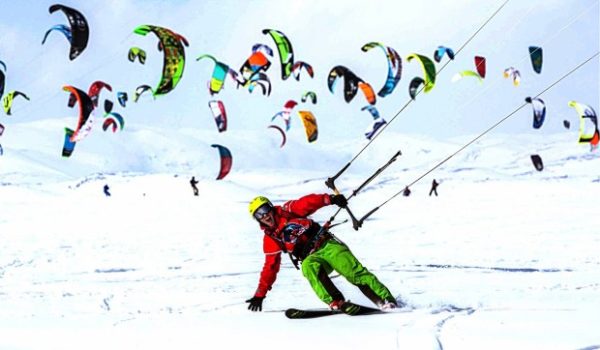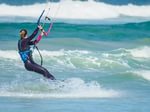“Lone wolf” snowkiting enthusiasts in Minnesota have hooked their foils to an established pack of wind experts — sailors — and are hoping to ride into a stronger, more competitive future.
Michael Kratochwill, owner of Lakawa, a kite boarding store and school in White Bear Lake, helped create a partnership with the Wayzata Yacht Club with dreams of elevating the sport, possibly to Olympic levels.
“What happens with a yacht club is they are a sailing-driven community,” he explained. “Coupling up my business with the yacht club has been helpful in bringing a greater awareness to my business. There’s a much grander support network there.”
He said the partnership will foster a fellowship of the wind among kiters and help “peel away from that lone wolf mentality as well.”
RESPECTED HERE, BUT NOT INTERNATIONALLY
Appearing in Minnesota in the late 1990s, snowkiting involves a rider on skis or snowboard tethered to a large kite that pulls him across a frozen lake. The sport has evolved to an annual 28-mile endurance race across Lake Mille Lacs at the end of February, an event famous for being the longest running and longest distance snowkite race in the U.S.
From 2004 to the present, the number of kiters participating in the race has grown from 30 to 100. And although there are an estimated 600 kiters in the state based on sales data, the race hit the 100 mark in 2008 but hasn’t really gained much momentum size-wise since then. At least not like it has in other countries.
“We are behind internationally,” said Kratochwill, who has snowkited in races around the world. He tells of uniformed international teams with protocols and slick gear at meets that made him feel like a novice farm kid with a kite.
Following their lead, Kratochwill and others learned that one way to boost their game was to join forces with sailors, an established group that are masters at working the wind.
TAMING THE WIND
The partnership with the Wayzata Yacht Club is entering its second season of racing at the Wayzata Community Sailing Center on Lake Minnetonka. Between 10 and 20 kiters meet Sundays during January and February to play and to practice for the Mille Lacs event. The close proximity has resulted in sailing lingo creeping into the snowkiting vernacular.

“This is the first organized snowkiting fleet in North America,” said Gretchen Wilbrandt, executive director of the Minnetonka Yacht Club. She explained that in sailing, fleet racing means that boats racing against each other are all the same — the same design, the same sail area, etc. In the same way, the snowkiting fleet all race with similar gear following the same rules and safety protocols.
Kratochwill thinks this is the way Minnesotans will be able to compete internationally.
A TALE OF TWO RACE STYLES
While the Mille Lacs race tests endurance — “It’s literally holding one leg really, really hard for 14 miles and then switching to the other leg to come back,” Kratochwill said — the “regatta”-style racing, as is done in partnership with the yacht clubs, is more about mastering different skills.
The races, called “buoy” races, are shorter with more specific tests, such as tacking against the wind, jibe sailing or using crosswinds.
“Regatta is highly technical,” he said. “Twenty-five percent of the victories are won right at the start.”
The other difference with the yacht-style partnership versus just heading to the lake to practice is that the group still meets even if the wind isn’t cooperating.
“I think seeing a collective and knowing there’s a safe space to learn helps,” Wilbrandt said. “You get that sense of community and sharing.”
FREEDOM VS. STRUCTURE VS. KITEMARES
When describing the sport, Kratochwill straddles the two worlds of the easy freedom of kiting whenever and wherever with the desire to win the world’s respect, something that requires more rules and less freedom.
“We’re highly portable,” he said. “You can throw your backpack and skis in the car and go wherever.”
There are no state regulations on snowkiting yet, either, he said. Not that he’s asking for regulations, but in regard to safety, he does want to raise awareness of the need for kiters to not just venture out alone without lessons. Those who do often end up in “kitemare” videos online of unlucky riders being lifted up over 30 feet in the air or dragged across a beach.
It’s easy to find equipment online and just head to the lake. But there’s a reason most of the kiters in Minnesota are not in their teens and early 20s. While being pulled on skis seems easy enough, it’s the skills to know what to do when the wind changes that take time to develop. Also, the kites can be pricey, some up to $2,000 each.
“They (newbies) think they’re in control, but they’re not,” Kratochwill said. “If you don’t know how to do it, you’ll probably end up in a kitemare video.”
Josh Ernst, 43, of May Township, is an experienced kiter who has competed in the Mille Lacs race several times. Even with all that know-how under his tether, he’s had a kitemare experience of his own.
“I was out with two buddies, one of which was my dad,” he said. “I had them on smaller kites and all that was left was the bigger kite. I thought, it’ll be fine. I can handle this. The wind picked up really fast, a big gust.”
He saw that his dad was struggling, so he tried to get over to him, but the wind caught his kite and picked him up high into the air and dropped him on his back, cracking a rib.
“You have to understand how strong the wind is versus how big of a kite to use,” he said.
THE CALL OF THE WIND
Once trained and experienced, kiters can relax a bit and enjoy themselves.
“It’s so beautiful to see all the 75-plus huge, colorful kites all running in the same direction,” Ernst said of his first time seeing the Mille Lacs event, which is set for Feb. 28, 29 and March 1. “As soon as I saw it, I was like, I have to do this.”
Wilbrandt, 31, was drawn to it for the adrenaline high.
Kratochwill likes the versatility, since kiting can be done in all seasons, just with slightly different equipment.
“Kiting gives us total access to our incredible outdoors,” he said. “As a life-long Minnesotan, I’m incredibly passionate about our four seasons and I love to be able get out and enjoy the change of the colors in fall while kite surfing, the hot surfing playing around on our 10,000 lakes and also snowkiting in the winter where we just gear up.”
All three said it’s the fellowship with like-minded windsmiths, something made more accessible with the yacht club collaboration.
“Just the fun of getting to ride with all the other kiters in the community,” Ernst said. “It’s the camaraderie of the event. That really is the allure for a lot of people.”





Recent Comments